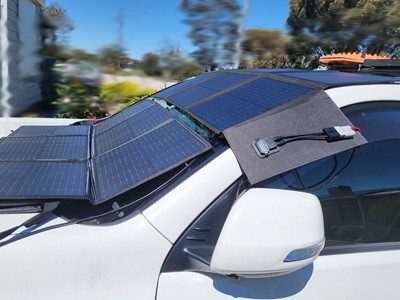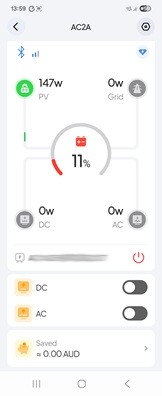I recently purchased an AC2A from Bluetti.Com.Au and with a very good deal. The RRP is AUD $399, the on special price was (and still is for a little over 2 days - 12 Nov 2025) $259. However, I had some Bluetti Bucks to use and secured a further $100 discount for a delivered price of $159. (60% off RRP)
Background - The AC2A was delivered at a SOC of 37% and was initially charged to 100%. Then discharged at approx 25W of DC load to 0% SOC ready to test its charging capacity from some of the avaialble solar.
The panels used were 2 x 120W XTM solar blankets placed on my 4x4 roof and bonnet (Hood for the readers over the Pond). Half of each panel was horizontal, the other half angled at the sun. Season is mid spring, ambient temp was 24C (Approx 75F), no cloud, full sun and tested between 1400 to 1600hrs. The panels were connected in Parallel. (WARNING - Do NOT connect any panels in series for this power station.)

During the first few % of charging, the charge mode was changed from Silent, to Standard and Turbo, noting the input Watts. And, Yes, changing these modes, will affect the solar charge input rate.
Silent

Standard

Turbo

To tabulate - Silent allowed 76W, Standard 122W and Turbo 147W.
For the remainder of the test, Turbo mode was selected. During the remainder of the test, although the rate fluctuated periodically from 145W to 149W, the noted 147W was constant.
The charge rate remained steady until the AC2A reached 99% SOC, increasing approx 1% per 55 seconds. (observed).
It took a further 10 minutes, the first half at approx 79W, then at 50W for charge to shut down and the AC2A reaching 100% SOC.
Total charge time was 1 hour 43 minutes. Total input was 210Wh, both measured by a DC power meter.


I also noted that under load the solar input voltage was a little over 18V and neared 22V when charge completed. Input Amps observed were approx 8.2A.
CONCLUSIONS
- “Overclocking” Solar Watts and Amps is OK. The panels used totalled 240W or 20% more than the AC2A’s 200W limit and never exceeded 150W in the real world. Their rated Imp totalled approx 11 amps)
- Setting the charge mode, either from AC or DC input, will limit charge input, regardless of available power. The panels were producing at least 150W, but at Silent/Standard setting were limited to a lower charge rate. Also something to be aware of when posting a “Why is my solar input so small from panels I know are producing so much more?” Lol.
- The reason for the limited tested input from my Solar Mats is the output voltage. 18V x 8.2A = 147.6W, which is what I got at maximum input Amps. It is likely my panels were producing a higher amperage, however, at their limited (by the AC2A) current of 8.2A and at a much lower than it’s 28VOC limit of 22VOC (when fully charged, no load), I got everything out of these panels I could expect.
I will be using the AC2A in my Caravan (RV), which has house batteries charged via 360W of solar.
If left in the RV, whilst away from camp, it will likely be charged via a Cig Socket from the house batteries in Silent mode as that is approx 4 amps at 13V.
If carried in the 4x4 it could be charged similarly from a Cig Socket, or the Charger 1. In the case of the Cig Socket, I would use Silent mode due to the limited capacity of these plugs.
If RV solar is at a premium, it could be charged from the above solar blankets as they are in addition to the noted 360W RV solar. And, failing all of that, I carry a small petrol generator. ![]()
Hope this is of assistance and a similar logic is usable for other small/medium power stations and small medium solar arrays.
To compare the inputs I noted above, the AC2A was again depleted and put on charge but this time from the grid at 240VAC. These are the observed input Watts at the three charge rates, noted on the AC2A display, along with its estimated charge times.
Silent mode 75W for a 2.6 hour cycle - Standard mode 124W for 1.6 hours - Turbo -270W for 0.8 hours.
To recap, from solar I noted 76W, 122W and 147W respectively. Both Silent and Standard modes are close enough to show a close comparrison, However as noted above, I think the Turbo mode when from solar is “clipped” due to the achieved maximum amperage and the lower than optimal Vmp of the solar array.
As a C rate of charge - Silent = 0.37C, Standard = 0.61C and Turbo = 1.32C. My opinion - Turbo charge at that rate, unless absolutely necessary, should not be used. Standard charge can be used, but sparingly, if you need to do so. As a go to, Silent mode, should be used wherever possible. Why? At 75W for a small battery of 204.6Wh, 2.6 sun hours to fully charge from 0% to 100%, using a 200-240W array is easily done.
Also, and again my opinion, for a small battery size and relatively small output device, I would prefer to not deplete to zero, too often. My Elite 100v2 powers my RV microwave, or Air Fryer, or Induction Stove, rarely more than one device on any given day/meal. The M/Wave uses around 15-20%, Air Fryer and Induction Stove maybe 5-10% more. I then recharge before its next use = approx 300Wh or less than a 1/3 of capacity, which reduces charge time as well as increasing cycle life. So far, always in Silent Mode as time is rarely an issue for me. The AC70 powers my electric kettle, toaster and sandwich press and I have an LPG stove to go to if necessary for all 3 needs.
My use for the AC2A -
Charging an electric shaver, electric toothbrush, 18650 torch batteries, Ryobi 18V batteries, metal detector equipment etc. all low wattage devices or charging within the 300W inverter limit.
A secondary use, still to test, is; Starlink Mini, with a Peakdo mini power bank which is less than 200Wh. It has a USB-C bi-directional charging port, which can be plugged into the AC2A USB-C PD 100W port, effectively doubling capacity to around 400Wh, which should at an average load run the WiFi (dish) for close to 8 hours.